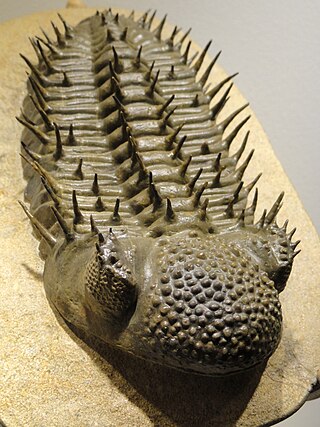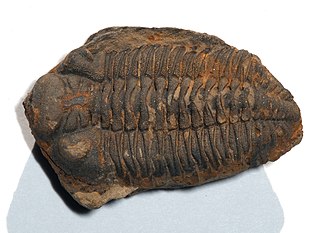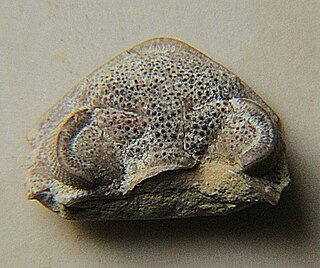
Phacopida ("lens-face") is an order of trilobites that lived from the Late Cambrian to the Late Devonian. It is made up of a morphologically diverse assemblage of taxa in three related suborders.

Ptychopariida is a large, heterogeneous order of trilobite containing some of the most primitive species known. The earliest species occurred in the second half of the Lower Cambrian, and the last species did not survive the Ordovician–Silurian extinction event.

Proetida is an order of trilobite that lived from the Ordovician to the Permian. It was the last surviving order of trilobite, dying out in the Permian-Triassic extinction event.

The Phacopina comprise a suborder of the trilobite order Phacopida. Species belonging to the Phacopina lived from the Lower Ordovician (Tremadocian) through the end of the Upper Devonian (Famennian). The one unique feature that distinguishes Phacopina from all other trilobites are the very large, separately set lenses without a common cornea of the compound eye.

Phacopidae is a family of phacopid trilobites that ranges from the Lower Ordovician to the Upper Devonian, with representatives in all paleocontinents.

Phacops is a genus of trilobites in the order Phacopida, family Phacopidae, that lived in Europe, northwestern Africa, North and South America and China from the Late Ordovician until the very end of the Devonian, with a broader time range described from the Late Ordovician. It was a rounded animal, with a globose head and large eyes, and probably fed on detritus. Phacops is often found rolled up ("volvation"), a biological defense mechanism that is widespread among smaller trilobites but further perfected in this genus.

Dalmanitoidea is a superfamily of trilobites in the order Phacopida, containing the three families Dalmanitidae, Diaphanometopidae and Prosopiscidae.

Kainops is a genus of trilobites from the family Phacopidae, order Phacopida. It can be distinguished from Paciphacops by the greater number of facets to the eye. The form of the furrow between the palpebral area and the palpebral lobe also distinguishes Kainops from the genera Paciphacops and Viaphacops.
Eldredgeia is a genus of trilobites in the order Phacopida, suborder Phacopina, family Calmoniidae. This genus comes from the Devonian of South America and South Africa, usually found in nodules. The trilobite Eldredgeia venusta, from Bolivia, is the most common South American trilobite on today's fossil market, and even then it is not all that common. This genus has a spiny pygidium and usually the eye facets are well preserved.

Drotops is a genus of trilobites from the order Phacopida, family Phacopidae that lived during the Eifelian of the Middle Devonian. It was described by Struve in 1990 under type species Drotops megalomanicus. Their fossils are found in present-day Morocco, specifically the Maïder Region located South West of Erfoud.
Toxophacops is a genus of trilobites from the order Phacopida, family Phacopidae. It is from the Devonian period and is very small compared to other genera in Phacopidae.
Eophacops is a genus of trilobites from the order Phacopida, family Phacopidae. These trilobites lived during the Middle Silurian in what are now North America and North-West Europe. Species assigned to this genus can be distinguished from Phacops by their small size (2–3 cm). Eophacops has very large eyes compared to the rest of its body.

Acastidae is a family of trilobites in the order Phacopida, suborder Phacopina, superfamily Acastoidea, containing the following genera:

Calmoniidae is a family of trilobites from the order Phacopida, suborder Phacopina, superfamily Acastoidea.
Boeckops is a genus of trilobites in the order Phacopida, which existed in what is now the Czech Republic. It was described by Chlupac in 1972, and the type species is Boeckops boecki, which was originally described as Phacops boecki by Hawle and Corda in 1847. Boeckops is also been discriped from the lower Devonian of Morocco and Algeria. The Genus Boeckops is interpreted as intermediate from between the traditional genus concept of Phacops and Reedops. The Genus Boeckops is regarded as problematic or difficult by McKellar et Chatterton 2009.
Calyptaulax is a genus of trilobites in the order Phacopida that existed during the middle and upper Ordovician in what is now the U.S. states of New York, Oklahoma, Illinois, Missouri, Virginia, Vermont, Nevada, Iowa, Wisconsin, Kentucky, and Iowa, as well as the Canadian provinces of Ontario, Newfoundland and Labrador, Quebec, and the territory of Nunavut. Other countries Calyptaulax fossils are known from include Ireland, Norway, Russia, and the United Kingdom.
Illaenula is a genus of trilobites in the order Phacopida, that existed during the middle Devonian in what is now the Czech Republic. It was described by Chlupac in 1977, and the type species is Illaenula illaenoides, which was originally described under the genus Ductina. The type locality was the Stínava-Chabicov Formation, in Moravia.

The Pterygometopidae are a family of trilobites, that is known from the Floian to the Katian (Ordovician), and reappears from the Telychian to the Sheinwoodian (Silurian). As part of the Phacopina suborder, its members have schizochroal eyes.

Viaphacops is a genus of trilobites in the order Phacopida, family Phacopidae, that lived during the Middle Devonian, and is known from North and South America, Asia.

Librostoma is a subclass of trilobites defined by having a natant hypostome, which is a hypostome that is free from the anterior doublure and aligned with the anterior of the glabella, this is unlike a conterminant hypostome, which is attached to the exoskeleton.













